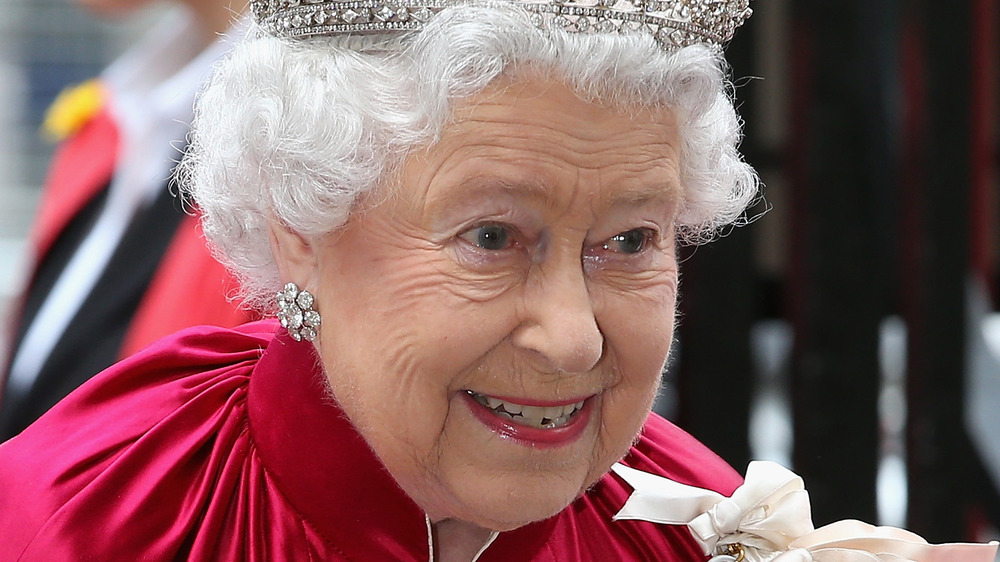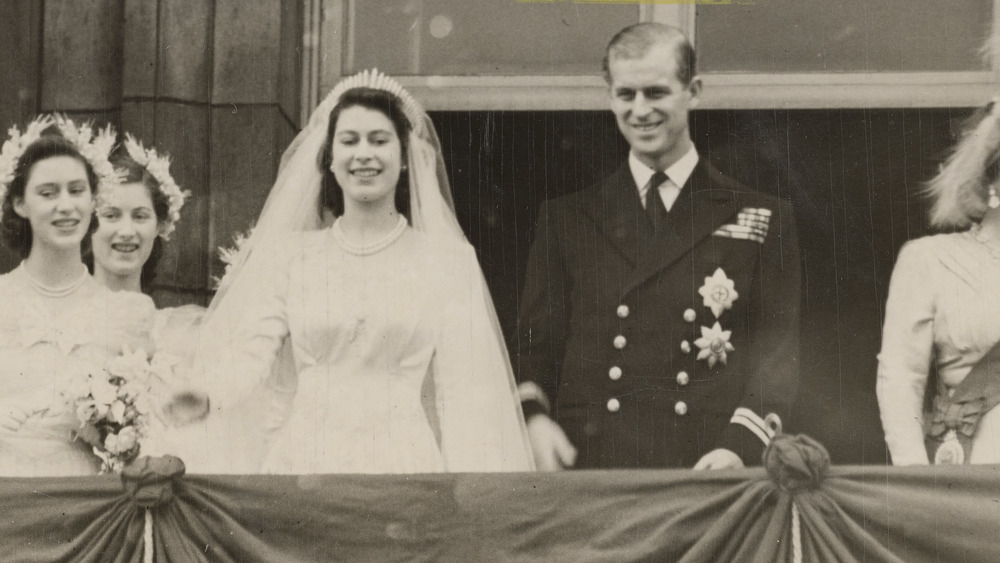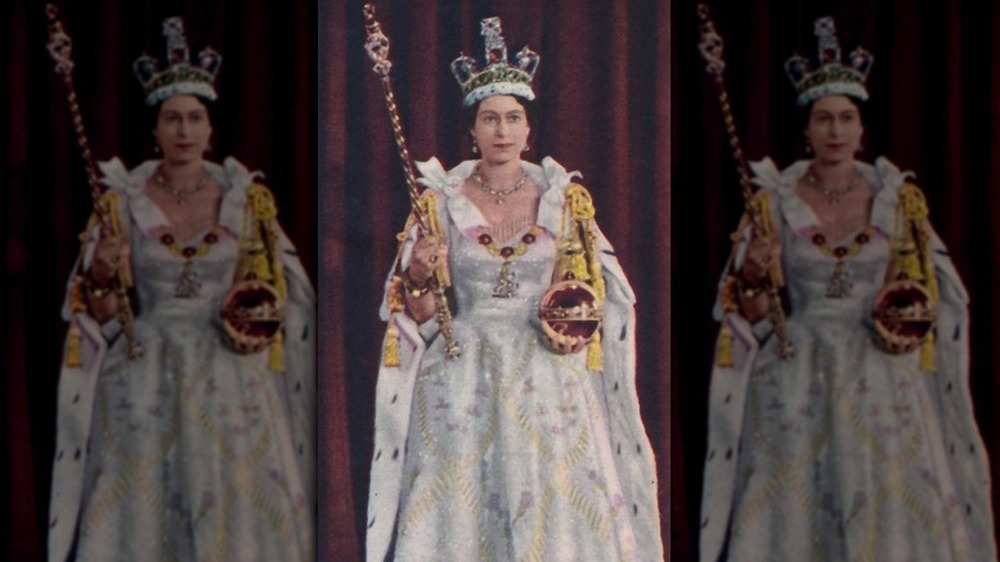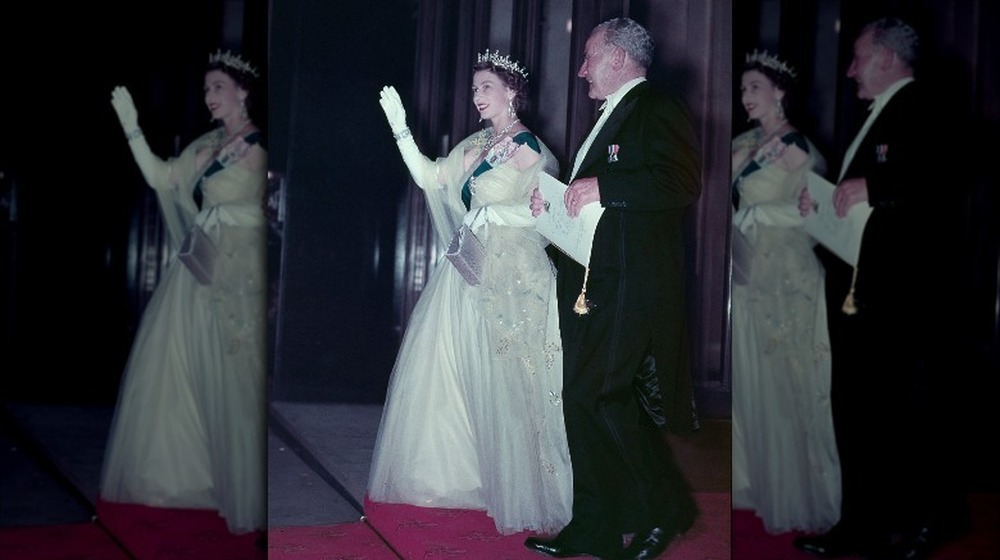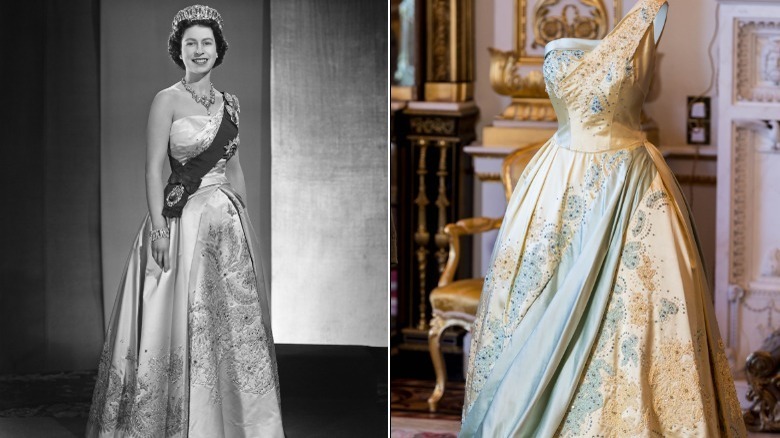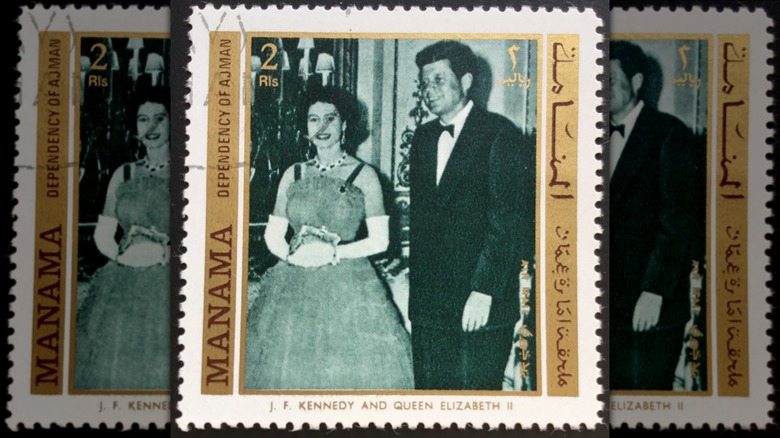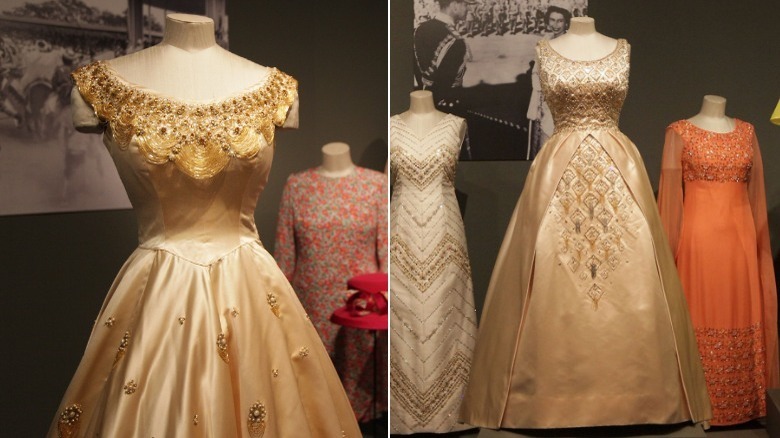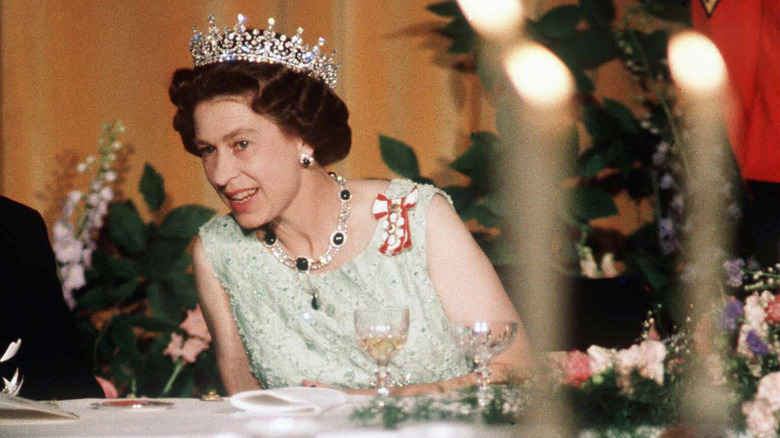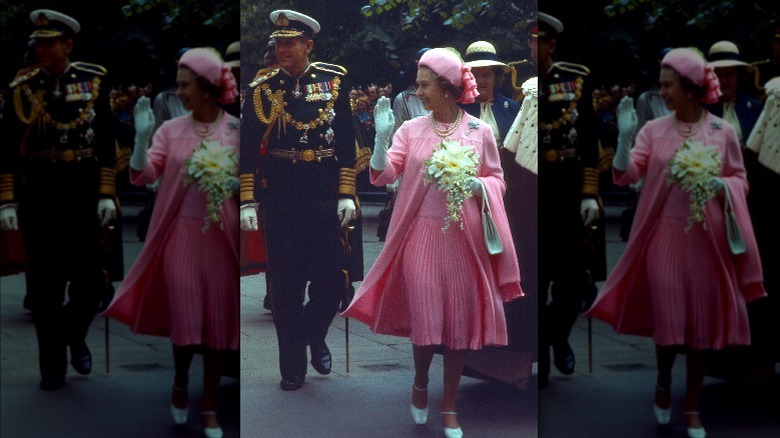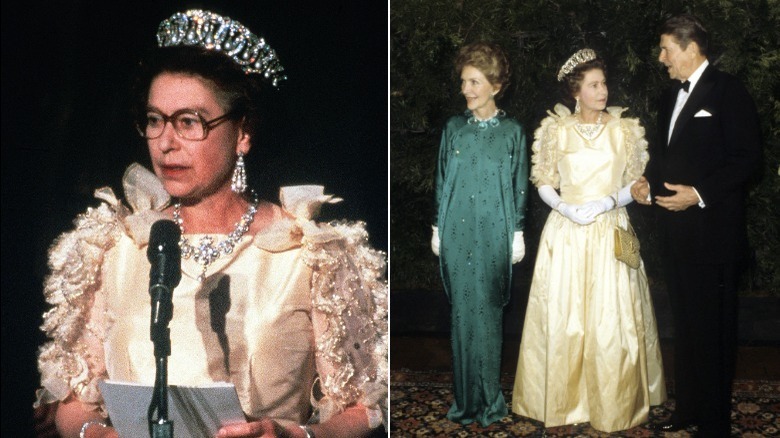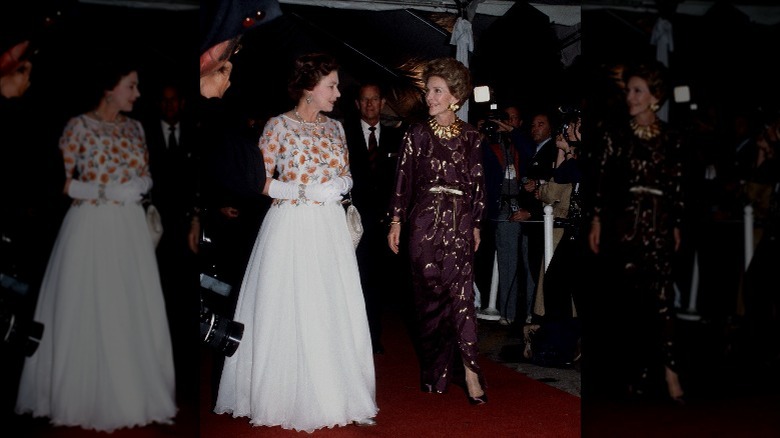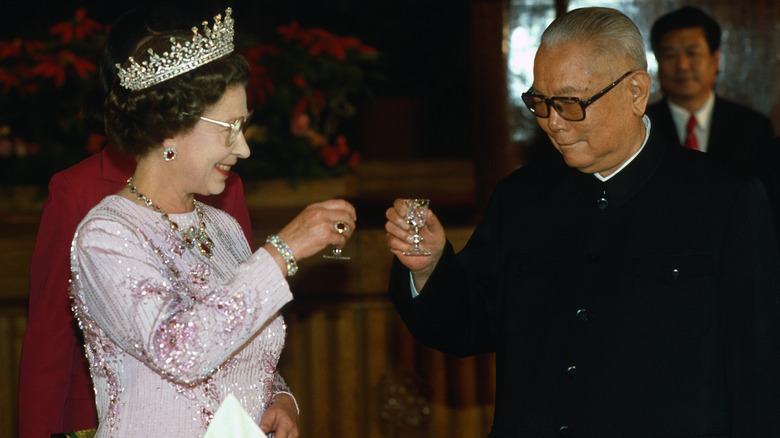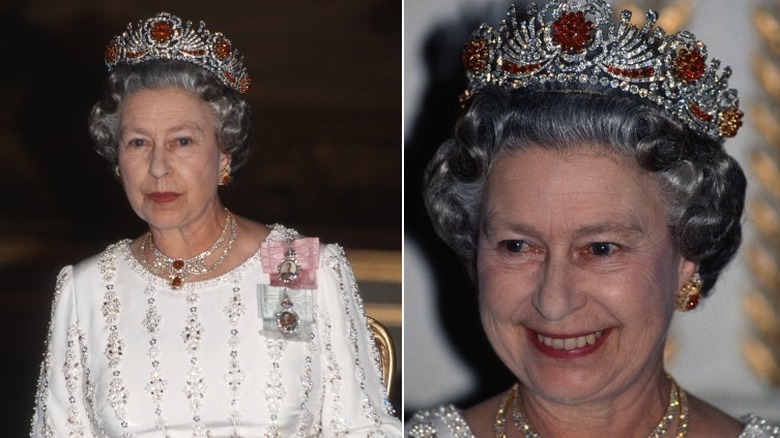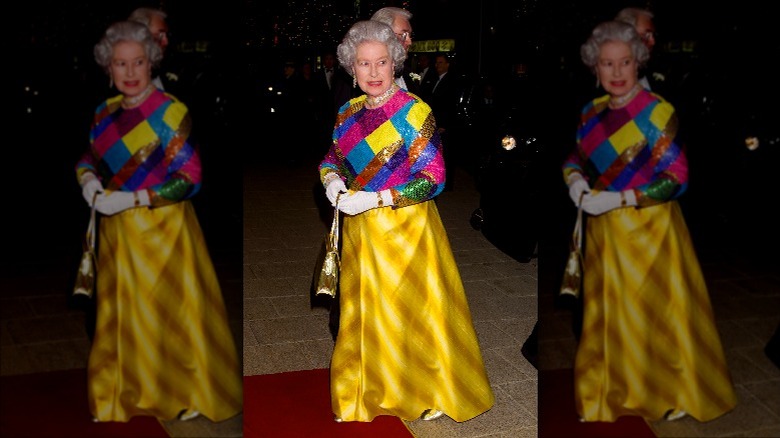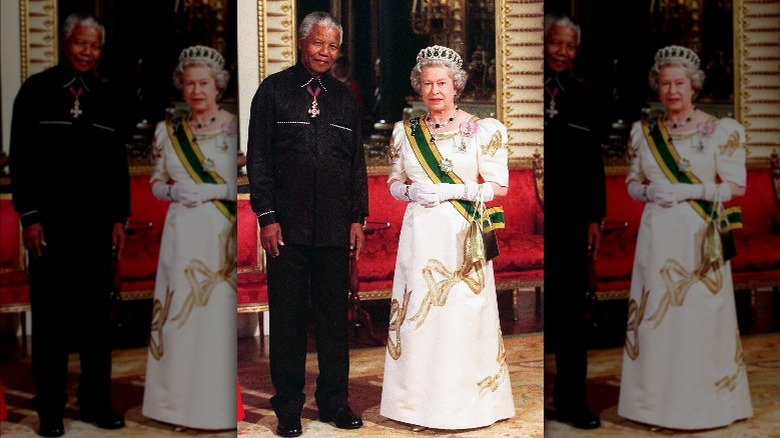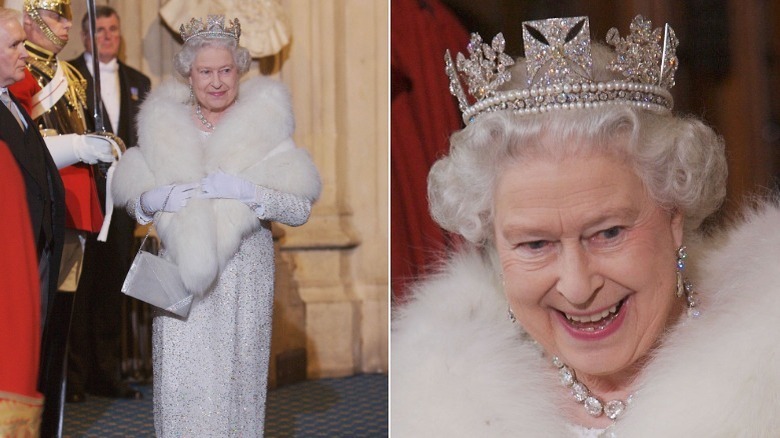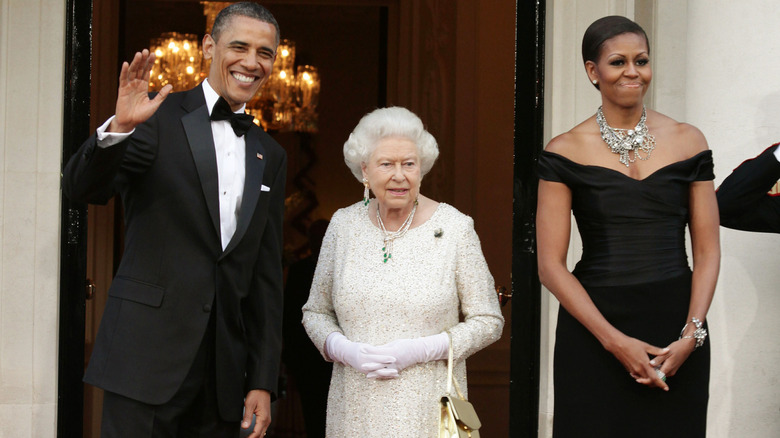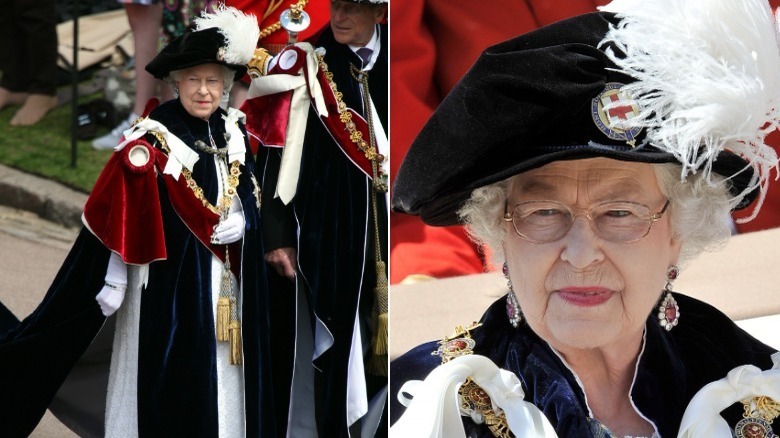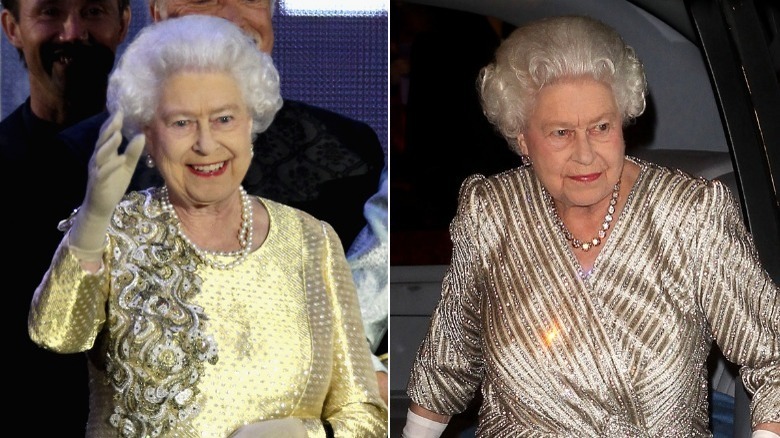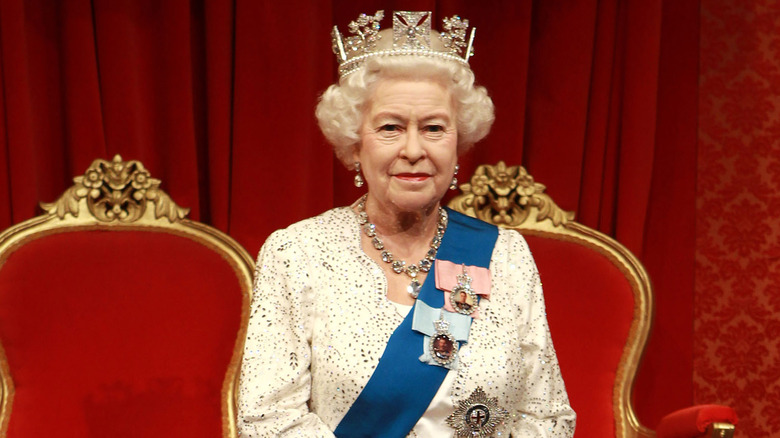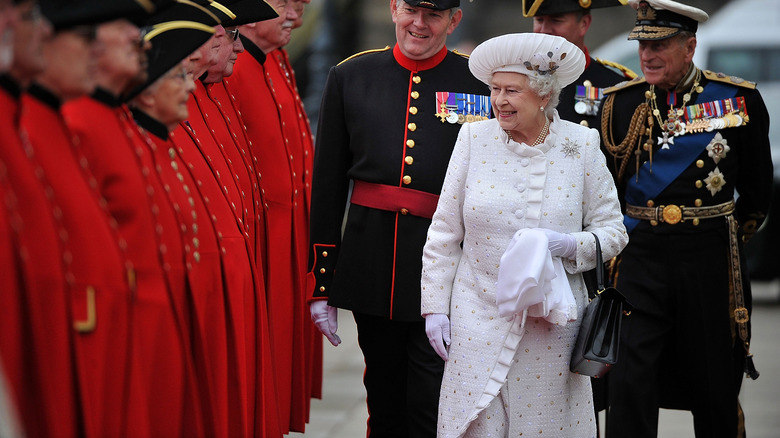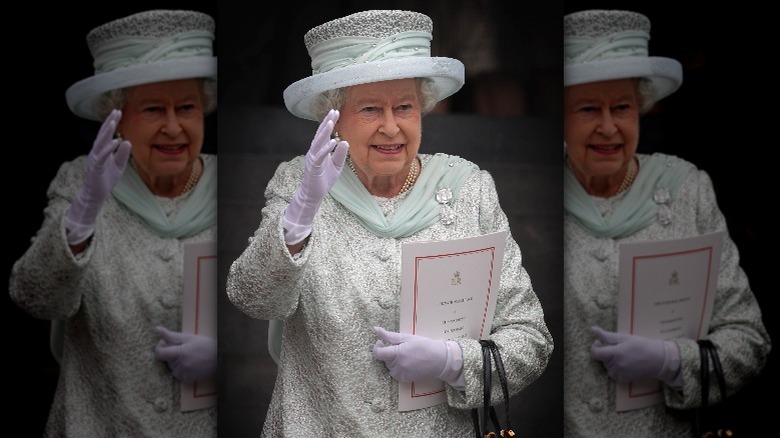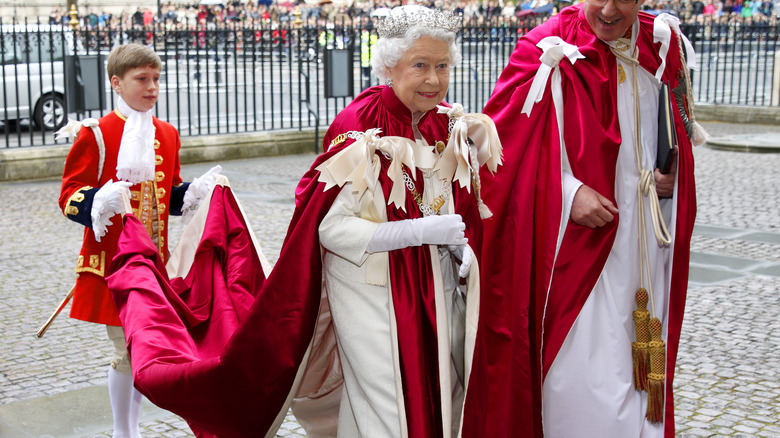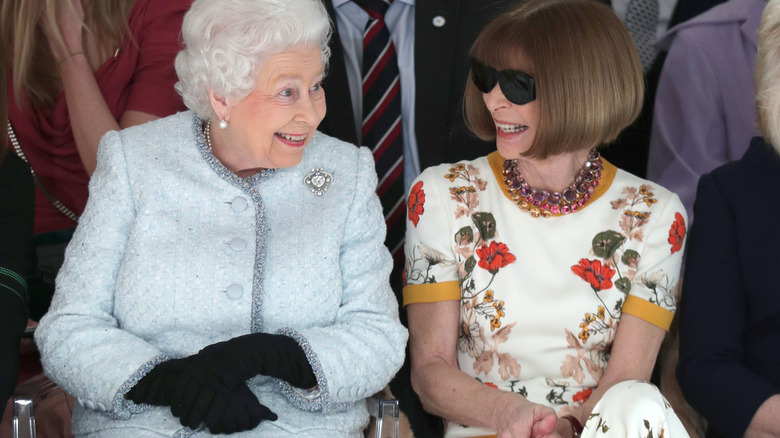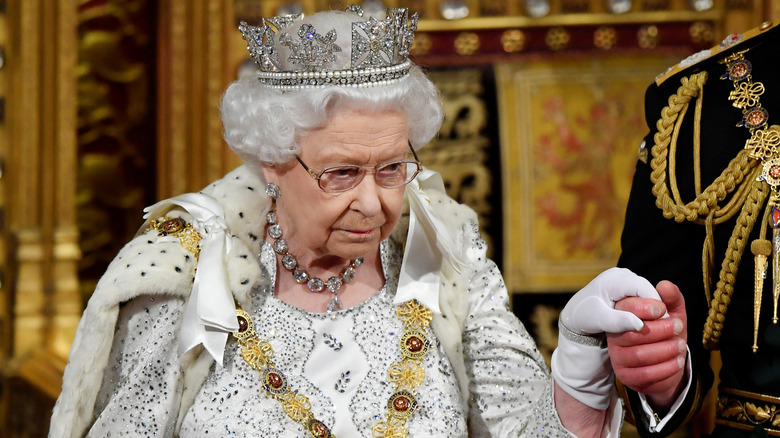The Most Lavish Outfits Queen Elizabeth Ever Wore
We may receive a commission on purchases made from links.
"I have to be seen to be believed," Queen Elizabeth II once said, according to biographer Sally Bedell Smith (via The New York Times). Her Majesty could have been referring to her need for public engagements in order to build rapport with the people in Britain and overseas, but the quote could be applied just as well to her sartorial choices. She had a well-known flair for bright candy colors and dramatic headpieces, but according to her daughter-in-law Sophie, the lesser-known reason behind the queen's wardrobe choices was to help members of the public to spot her through crowds.
Her Majesty's special occasion attire and accessories were similarly striking. When a new monarch inherits the throne, she inherits the responsibilities of upholding tradition not just through her rule but also through her regalia. The queen inherited access to the sparkling crown jewels that have been in her family for centuries, the ceremonial capes and accoutrements customary for royal events, and the expectation to meet certain standards in magnificence and modesty. Some of her most lavish looks were strictly traditional, while others reflected the trends of their time. Still, each carried an opulence that had to be seen to be believed.
Queen Elizabeth II's wedding dress was a sight to behold
On November 20, 1947, two years after the end of World War II, Princess Elizabeth married Lieutenant Philip Mountbatten. Britain was still reeling from the darkness of the previous years, but the royal wedding was, according to Time, "the first great celebration of the postwar era."
According to the Royal Collection Trust, top couturier Norman Hartnell's design for Elizabeth's wedding dress was approved in August of 1947, just three months before the wedding took place. Good Housekeeping reported that 350 women worked on the dress over a span of seven weeks. Inspired by Botticelli's Primavera, the dress had hand-embroidered, pearl-encrusted flowers blooming all over it. More than 10,000 seed pearls spangled the dress atop silk spun by silkworms from China, since Japan and Italy were Britain's enemies during the war.
The dress was especially luxurious in the postwar era due to the 15 feet of silk and tulle that made up its train, as fabric was still rationed in Britain at the time. The royal family was not exempt from wartime rationing, so the princess paid for her wedding dress with rationing coupons — although, per the New York Post, the British government gave her 200 extra coupons to help.
Queen Elizabeth II's 1953 coronation gown took eight months to complete
In the summer of 1953, a 25-year-old Princess Elizabeth was to be crowned the Queen of England, so she enlisted couturier Norman Hartnell — who had previously designed her wedding dress — to create a coronation dress fit for a queen. According to Harper's Bazaar, the dress took eight months to make, including time for Hartnell to research the sartorial traditions of previous coronations, to create and present nine designs for the queen-to-be, and to orchestrate the crafting of the gown in all of its detailed glory.
After conducting his research at a museum and a library in London, Hartnell retreated to Windsor Forest to start sketching. "My mind was teeming with heraldic and floral ideas," he recalled in his 1955 memoir Silver and Gold (via Harper's Bazaar). "I thought of lilies, roses, marguerites and golden corn; I thought of altar cloths and sacred vestments; I thought of the sky, the earth, the sun, the moon, the stars and everything heavenly that might be embroidered upon a dress destined to be historic."
Hartnell's eight months of hard work paid off, and the new queen was so pleased with the end result that she went on to wear the gown on six different occasions.
Queen Elizabeth II's wattle gown helped strengthen ties to Australia
When Queen Elizabeth II voyaged to Australia for the first time in 1954, approximately 75 percent of the continent's 9 million population "glimpsed her in person at least once," according to the National Museum of Australia. It's fitting, then, that the young queen wore one of her most iconic looks to a state banquet in Sydney as a nod to the people of Australia (via The Australian Women's Weekly).
Her "wattle dress" was a gold tulle gown adorned with golden wattles. Australia's national flower is the golden wattle, so the dress was recognized as "unambiguously patriotic," per the National Museum of Australia. Sir Norman Hartnell designed the dress specifically for Her Majesty's visit to Australia.
The dress was immortalized later that year when Australian artist William Dargie was commissioned to paint a portrait of the queen wearing it, which became known as the "wattle painting." The original portrait was given as a gift to the Australian Commonwealth; another was gifted to the queen for her personal collection; and a reproduction was later purchased by the National Museum of Australia.
Queen Elizabeth wore an asymmetrical gown and a Russian tiara in the Netherlands in 1958
Queen Elizabeth II wore yet another design by Sir Norman Hartnell to a state banquet on the first night of her 1958 visit to the Netherlands. As noted by the Royal Collection Trust, the evening gown showed off the best of its designer's usual aesthetic: sparkling embellishments, detailed embroidery, and a full skirt. Constructed of muted aquamarine and champagne crinoline, it featured a fitted, structured bodice with a thick strap over one shoulder. At the waist, the gown billowed out into a voluptuous skirt interrupted by a diagonal swath of pale blue fabric. It was accentuated by unique embellished shapes and tiny jewels in colors to match the fabric throughout.
As if her gown weren't opulent enough, the queen accessorized with an array of diamonds and pearls. Atop her head sat the Vladimir Tiara, which Town & Country reports is one of Her Majesty's favorites. The tiara, which originally featured hanging pearls, belonged to Grand Duchess Vladimir of Russia before it was sold to Queen Elizabeth II's grandmother Queen Mary. On certain occasions, Queen Elizabeth swaps out the pearls for her great-grandmother's emeralds, but she appears to have opted for classic pearls for the 1958 banquet.
The queen wore a formal blue ballgown when hosting the Kennedys in 1961
In 1961, the new president of the United States, President John F. Kennedy, and First Lady Jackie Kennedy visited Queen Elizabeth and Prince Philip at Buckingham Palace (per British Heritage Travel). For the occasion, Elizabeth wore a royal blue A-line tulle ball gown from Hartnell, accessorizing with white gloves and diamond and sapphire jewelry (via Yahoo).
The visit, however, reportedly wasn't without some drama. Per The Telegraph, the first lady, dressed in a sleek blue, column-style silk gown by Chez Ninon, considered modern for the time, allegedly "was unimpressed by the palace furnishings and by the Queen's dress and hairstyle." And, according to the biography, "America's Queen," Jackie allegedly told a friend, writer Gore Vidal, "I think the queen resented me. Philip was nice, but nervous" (via Reader's Digest).
After the Kennedys' return to the states, the president sent the royal couple a thank you note, which read in part, "We shall always cherish the memory of that delightful evening" (via Yahoo!). Following the first lady's visit with the queen one year later, she apparently put to rest any rumored drama, allegedly telling the press, "I don't think I should say anything about it except how grateful I am and how charming she was" (via Reader's Digest).
In 1963, Queen Elizabeth favored shimmering Norman Hartnell evening gowns
In 1963, Queen Elizabeth II appeared to adopt a glamorous evening uniform: bejewelled metallic Norman Hartnell gowns, white fur stoles, delicate evening purses with chain straps and clasp closures, and, of course, royal jewels.
In its Fashioning a Reign exhibition, the Royal Collection Trust showcased notable Norman Hartnell designs the queen wore in 1963. To the state opening of New Zealand's Parliament on February 12, she wore an evening gown with a "scoop-necked bodice and a scissor-cut skirt" in "oyster duchesse satin" with "silver and gold embroidery in a geometric design," as noted by the Royal Collection Trust. As seen in photos (via Today), she completed the look with a fur stole, a tiara, and an official sash decorated with brooches.
The following May, Queen Elizabeth wore a fitted evening gown of silk tulle, "vermicelli embroidery," and beaded diamond shapes to a banquet with the king and queen of Belgium. That same month, Her Majesty attended a British Red Cross film performance, wearing Hartnell's 1960s interpretation of a 17th-century "robe de style." The gown featured a fitted, beaded, slightly off-the-shoulder bodice and a bouffant skirt in a golden yellow fabric, which the queen accessorized with a stole, delicate purse, gloves, sash, and sparkling jewels.
For her Silver Jubilee, the queen put her shiniest foot forward
In 1977, Queen Elizabeth II celebrated her Silver Jubilee, which marked 25 years since she took the throne as monarch. On May 31 of that year, The New York Times ran an article covering the gala in Covent Garden. "The Queen herself wore a white crepe gown trimmed with silver and crystal, the blue sash of the Order of the Garter and ruby and diamond earrings, a necklace and a tiara," read the publication. "It was difficult to remember that Britain is a country in deep economic trouble."
Her Majesty wore several lavish outfits that year, such as the embellished gowns she wore for her official portrait and the state opening of New Zealand's Parliament in February, and she ended on a bright note. In Canada, the last stop on her international Silver Jubilee tour, she attended a state banquet in Quebec with then-Canadian prime minister Pierre Trudeau, as noted by CBC. In a departure from the soft metallics she favored for special occasions in previous decades, the queen wore a seafoam green, gem-encrusted sheath dress and an especially regal tiara as she celebrated a quarter-century of her monarchy (and queenly glamour).
She greeted the crowds in pink pleats during her 1977 Silver Jubilee
Queen Elizabeth II was well-known for wearing bright colors in public — one being pink. In June 1977, during her Silver Jubilee — her first jubilee, commemorating 25 years behind the throne — she celebrated with a royal procession to St. Paul's Cathedral wearing a pink pleated dress and coat resembling a cape, each designed by Sir Hardy Amies. Royal Central referred to the outfit as "one of the most important outfits she's ever worn."
Noting that over 1 million people watched the procession, with another 500 million tuning in from home, the Royal Collection Trust described the outfit as a "striking ensemble of dress, coat and stole in pink silk crepe and chiffon with a matching hat designed by Simone Mirman with flowerheads hanging from silk stems" (via Royal Central). The matching hat by Frederick Fox included 25 bell-shaped flowerheads hanging from long, green silk stems, with yellow stamens added to the flowers to appear more realistic. The queen's jewelry included her Williamson Pink Diamond brooch, featuring a rare pink diamond — a wedding gift from Canadian geologist John Thoburn Williamson. Per Royal Central, the brooch — a known favorite completed the year she was crowned — also included over 200 white diamonds.
Queen Elizabeth dialed up the Hollywood drama during a 1983 visit with President Ronald Reagan
In February and March of 1983, Queen Elizabeth II and Prince Philip took their first tour of California. According to the Los Angeles Times, the royals visited space shuttles and the Yosemite National Park and attended a ritzy dinner in Los Angeles with the likes of actor Michael Caine. They also took a stormy ride up to President Ronald Reagan and First Lady Nancy Reagan's hilltop ranch in a Chevy Suburban, which Her Majesty deemed "terribly exciting."
At an honorary dinner in San Francisco on March 3, the queen toasted the president's warmth and the state's "magnificent technological achievements," noting that Silicon Valley "has brought the world of yesterday's science fiction into today's home" (via the Ronald Reagan Presidential Library & Museum).
In keeping with sci-fi style, Hollywood glamour, and the brightness of the Golden State, Her Majesty wore an uncharacteristically avant-garde metallic evening gown for the occasion. As seen in photos and video of the event, the soft-gold gown featured a dropped waist and dramatic ruffled and jewel-adorned sleeves topped with large bows at the shoulders, proving that even the queen of England herself was hip to the big shoulders of the '80s.
The queen joined Ronald and Nancy Reagan in 1983 wearing an embroidered white gown
In February 1983, when Queen Elizabeth and Prince Philip traveled to Southern California, they were hosted by then-President Ronald Reagan and First Lady Nancy Reagan at a lavish estate on the grounds of 20th Century Fox studios. Detailed in a New York Times report from the time, the shindig included a who's who of Hollywood royalty, such as Elton John, Fred Astaire, Lucille Ball, Wayne Newton, Gloria and Jimmy Stewart, Loretta Young, Bette Davis, and Master of Ceremonies Ed McMahon, with performances from Frank Sinatra, Perry Como, Dionne Warwick, and George Burns.
The newspaper described the queen's outfit as a white chiffon dress with a bodice embroidered with orange California poppies, California's state flower. The queen also opted to go without a tiara. Her penchant for symbolism displayed within her clothing, brooches, and jewelry paved the way for other prominent female royals and politicians including Princess Catherine and former U.S. Secretary of State Madeleine Albright.
According to Financial Times, Sir Hardy Amies, who designed the lavish dress, was responsible for much of the queen's wardrobe from the 1950s through the 1990s. The outlet explained that the queen considered his designs more welcoming to the public, citing a 1997 quote from the designer to the Sunday Telegraph: "There's always something cold and rather cruel about chic clothes, which she wants to avoid."
The queen looked glamorous in pink and jewels during a 1986 tour of China
Over her 70-year reign, Queen Elizabeth toured multiple countries representing Great Britain. During one such visit to China in October 1986, in which the queen became the first British monarch to visit the country, she donned a glamorous look at a banquet with Chinese leaders Deng Xiaoping and Wu Xueqian. Her pink dress by Ian Thomas was detailed with tree peony blossoms, the country's national flower, according to Good Housekeeping. She accessorized the look with an array of diamonds and jewels, from her large tiara to her statement ruby necklace and coordinating earrings.
These well-planned outfits with intricate detailing to pay homage to the various countries the monarch would visit did not go unnoticed and served as a form of flattery, with University of Westminster politics and international relations lecturer Daniel Conway telling the CBC in 2016 that the queen's fashion played a key role in her diplomatic relations with foreign countries. "In the modern era, dress in particular has been used by the British monarchy as part of British foreign policy," he said.
She wore her evil-banishing Burmese Ruby Tiara on a 1992 visit to France
On June 9, 1992, Queen Elizabeth II attended a banquet at the Elysee Palace in Paris during a state visit to France. She wore a long-sleeved white gown spangled with floral-patterned embellishments of tiny pearls and gems and topped with diamond-encrusted brooches. Still, it was the queen's jewels that truly dazzled: She wore her precious Burmese Ruby Tiara, along with a matching necklace and earrings.
According to WWD, the queen had the tiara made in 1973 using 96 rare rubies she received as a wedding gift from the people of Myanmar nearly three decades prior. The rubies are embedded among diamonds set in gold and silver, forming Tudor rose designs.
Gemologist Alexandra Mitchell estimated the tiara to be worth 7 million British pounds, the equivalent of approximately $9.5 million, per Express. In Burmese culture, the stones are reportedly believed to "ward off evil" and disease, so the tiara has been speculated to carry a secret meaning when worn by the queen. Her Majesty may have worn the jewelry to the 1992 banquet because the event took place in the midst of then-Prince Charles and Princess Diana's highly scrutinized separation — or perhaps simply because of its glittering beauty.
In 1999, Queen Elizabeth selected a bold fashion choice
In 1999, Queen Elizabeth decided to go daring for the Royal Variety Performance at the Birmingham Hippodrome for the venue's 100th anniversary, per Elle. The queen celebrated in a multicolored outfit. Express referred to its "harlequin" style, featuring a top adorned with multicolored sequins in pink, blue, yellow, orange, purple, and green in a diamond-shaped pattern. Her golden yellow long skirt was accented with angled stripes. She accessorized the look with a small gold handbag and matching heels. Her jewelry included a statement pavé-set diamond necklace in a cuff style and diamond fringe earrings, a gift from King Hassan II of Morocco. She wore minimal makeup — blush and pink lipstick — letting the ensemble do the talking.
The outfit was "a complete change" from the queen's usual monochromatic look, according to her dressmaker, Maureen Rose (via Express). "We are trying to show her off a bit," she said. Interestingly, the queen was never seen in the dress again, though the public's response to it was generally positive. "People seemed to be thrilled at how she looked. She was stunning," the dress' designer, Karl-Ludwig Rehse, told the Daily Telegraph (via Express). He added that he felt "overwhelmed" by the response. Of working with the queen, he said, "She's like all ladies, she'll go for something new. She's fun to work with and very knowledgeable about fabrics. She knows how the clothes have to behave — how they have to move."
The queen chose a festive gown for a May 2000 visit from Nelson Mandela
On May 3, 2000, Nelson Mandela, a close personal friend of the monarch, was the guest of honor at Buckingham Palace. For the occasion, Queen Elizabeth donned an ivory gown with puff sleeves and bows embroidered in gold, according to the book "Costume Since 1945: Historical Dress from Couture to Street Style" by Deirdre Clancy. She accessorized with white gloves and emerald jewels, among them the Grand Duchess Vladimir tiara and a green and yellow sash adorned with the Royal Family Orders, as Vogue noted.
According to Express, the two grew close after meeting in 1991. In an interview with the National News, Zelda la Grange, the late African leader's longtime personal assistant, elaborated on their bond, saying, "They shared the sense of duty, the sense of service and a calling that they adhered to throughout their lives, and there was a deep respect between the two of them." She also told Reuters, "When he paid visits to Queen Elizabeth, it was always very entertaining to see their interaction, because he called her 'Elizabeth.'" The two were so comfortable with each other, in fact, he would make comments to the queen that no one else would dare, as they shared a similar sense of humor. Once, he approached her and said, "'Elizabeth, you've lost weight!' and the queen burst out laughing," she told the National News.
The queen wore white fur and diamonds to the State Opening of Parliament in 2006
Through the decades, Queen Elizabeth II wore some of her most lavish looks for the State Openings of Parliament each year. During each ceremony, members of Parliament wear red robes, but Her Majesty typically stood out from the red sea by wearing some of her most dazzling embellished gowns in shades of white and silver.
On November 15, 2006, the queen arrived at the State Opening of Parliament in an embellished white gown, a white fur stole, white gloves, and her Diamond Diadem crown (via CBS News), which she'd worn for her arrival at several state openings as well as in the procession to her 1953 coronation. According to Express, the crown was originally commissioned for the coronation of King George IV. Reflecting traditional British, Scottish, and Irish symbolism in the form of roses, thistles, and shamrocks, it features 1,333 diamonds and is more than 320 carats.
As is tradition, the queen's stole and crown appeared to be replaced during the ceremony by her formal ermine Robe of the State and the Imperial State Crown, which features purple velvet and 2,868 diamonds in addition to precious rubies, sapphires, pearls, and emeralds.
She dressed to impress when hosting the Obamas in May 2011
Queen Elizabeth was said to be fond of former President Barack Obama. He and First Lady Michelle Obama visited Buckingham Palace several times over his two terms in office, but we're focusing on their 2011 visit due to the queen's lavish look. During the Obamas' visit on May 24, the queen hosted a state banquet at Buckingham Palace's Music Room. According to CBS News, the guest list consisted of world leaders and celebrities such as former Prime Ministers Tony Blair and Gordon Brown, Labor Party leader Ed Miliband, then-mayor of London Boris Johnson, and actors Kristin Chenoweth, Tom Hanks, Rita Wilson, Helena Bonham-Carter, and Kevin Spacey.
As Vogue noted, the queen wore a white embellished gown from designer Tom Ford with a selection of her most glamorous royal jewelry, including the Grand Duchess Vladimir tiara, pearl-drop earrings once belonging to Queen Victoria, the Golden Jubilee necklace, the Teck Corsage Brooch, a dressy pearl watch, a multi-strand pearl bracelet, and the Order of the Garter star, riband, and Lesser George. She also carried a small silver purse.
On Royal Garter Day in 2011, the queen donned a velvet cape and hundreds of diamonds
Each June, Queen Elizabeth II, along with members of the royal family and 24 selected knights, participated in the Order of the Garter ceremony at Windsor Castle. Ceremonial attire plays a key role in the annual event: the queen, senior royals, and the knights and ladies in the procession wore "grand velvet robes, glistening insignia, and plumed hats," per Royal UK.
On Royal Garter Day in 2011, the queen stood among the knights and ladies and fellow senior royals, including Prince William and King Charles III (then Prince Charles), per BBC News. The Order of the Garter procession was awash with matching midnight-blue velvet capes bearing Order of the Garter emblems on one side, red ribbons on the other, and white bows on each shoulder. Each member of the procession also donned a necklace bearing a large gold tassel, and a velvet hat adorned with a sizable white feather. Her Majesty typically stood out from crowds in opulent gowns or rainbow colors, but on this occasion, she was distinguished primarily by her Garter star brooch, which featured 838 brilliant diamonds.
2012 was a year of celebrations and metallic gowns
The year 2012 was one of pomp and circumstance for Queen Elizabeth II. It was the year London hosted the Olympic Games, and that of Her Majesty's Diamond Jubilee, which sparked several honorary events worth dressing up for.
In June, stars, including Sir Elton John, Sir Paul McCartney, and Stevie Wonder, performed for the queen at a Diamond Jubilee tribute concert, as noted by the Mirror. Her Majesty wore a shimmering number by dressmaker Angela Kelly for the occasion. The gold, long-sleeved dress featured a swirling silver-and-gold pattern over one side of the chest, recalling the glamorous metallics the queen favored in the early '60s. It's no surprise, then, that the dress was fashioned from fabric that had been bought in 1961 and was "hauled out of storage from the palace stock room," according to The Liverpool Echo.
In November, as the whirlwind year drew to a close, the queen attended the annual Royal Variety Performance, wearing a silvery, bejeweled gown — also designed by Angela Kelly — and tiny silver shoes to match (via Daily Mail).
Diamonds were the queen's best friend during her 2012 Diamond Jubilee
In 2012, to mark the occasion of 60 years on the throne, Her Majesty posed for an official portrait in the Centre Room at Buckingham Palace, as noted by Forbes. She donned a white silk dress adorned with lace, silver sequins, and a "scalloped edge" and designed by her royal dressmaker, Angela Kelly. In honor of her royal ancestors, the queen's royal blue Garter Riband sash was decorated with brooches bearing images of her grandfather and her father — King George V and VI, respectively — alongside the brilliant Garter star.
Emphasizing the "diamond" in "Diamond Jubilee," Her Majesty brought out some of the most sparkling pieces of the royal family's jewelry from the Royal Collection, including one of her most dazzling crowns, the State Diadem. She paired the crown with Queen Victoria's collet necklace, known as the coronation necklace, which has been worn to coronations since 1902, per the Royal Collection Trust. The necklace's drop pendant is the Lahore diamond, which is "one of the famous diamonds of the world," according to PBS. The outfit was later recreated for a wax figure of the queen, which lives at Madame Tussauds in London.
The queen wore an exquisite white outfit adorned with crystals during her Diamond Jubilee
For Queen Elizabeth's Diamond Jubilee in 2012, she undoubtedly dressed to be seen and to impress. In one jubilee event, which took place on June 3 of that year, the queen joined in a procession of 1,000 boats sailing the Thames River in her honor. She wore a stunning Angela Kelly-designed white coat, dress, and hat, which glistened from its dozens of Swarovski crystals, as the Daily Mail noted.
Silk organza ruffle accented the length of the coat and across the neckline, while the crystals were added to reflect the sparkling water. "When you see in detail the wool bouclé coat with its diamond-patterned silver threading, gold and silver dots, and sprinklings of Swarovski crystals you can't help but appreciate the delicate beauty of it," as The Guardian described.
The hat included a sculptured brim with an upward curve, designed to mimic the waves, its crown featuring the same fabric as the coat. The headpiece also featured hand-dyed feathers and a scattering of additional crystals and pieces of ivory organza (per the Daily Mail).
This glamorous Diamond Jubilee ensemble featured chiffon sashes and crystals
During her Diamond Jubilee, Queen Elizabeth debuted another lavish look. On June 5, 2012, she rode in a carriage procession from a service at St. Paul's Cathedral back to Buckingham Palace wearing another Angela Kelly creation. Per ITV, this one was a mint green and silver textured dress, coat, and hat. The silk tulle dress is embellished with silver, while a matching mint green chiffon scarf with Swarovski crystals was worn around the queen's neck. The queen paired the look with a hat featuring matching fabric and white gloves.
Adding to the ensemble, per The Court Jeweller, were her diamond-and-pearl earrings, multi-strand pearl necklace, and the Cullinan III & IV Brooch, which features two massive diamonds — one 94.4 carats and the other 63.6 carats — cut from the Cullinan diamond, the largest known diamond in the world.
In a diamond tiara and a red cape, Queen Elizabeth looked straight out of a fairy tale in 2014
Every eight years, Queen Elizabeth II attended the Service of the Order of the Bath. According to BBC, "The Order of the Bath is an order of chivalry dating back to 1725." The traditional service honors the installation of new knights at Westminster Abbey, where Her Majesty would make "the presentation of gold and silver coins, a symbolic surrendering of worldly treasures."
On May 9, 2014, the queen's appearance at the service prompted a PopSugar article aptly titled, "Look How Queen-y the Queen Was Today." In addition to a simple, long-sleeved, white dress and her typical silver heeled shoes and white gloves, Her Majesty wore striking royal regalia: ceremonial gold tassels, a diamond tiara from the Crown Amethyst Suite of Jewels, and a ruby-red velvet cape decorated with two traditional white shoulder bows. The cape featured a flowing train, which a uniformed young boy carried to keep it from touching the ground. It doesn't get much more queen-y than that.
She looked fashionable alongside Anna Wintour at London Fashion Week in 2018
In 2018, Queen Elizabeth attended her first-ever show at London Fashion Week, wearing a tweed skirt suit in pale blue paired with her Pearl Trefoil brooch (per Elle). The queen was on hand for Richard Quinn's show to present the designer with the first-ever Queen Elizabeth II Award for British Design, an award she called "a tribute to the industry and my legacy and all those who have contributed to British fashion" (per Who What Wear).
In what Insider described as an "iconic" moment, the queen, wearing black gloves, was seen in photos seated next to Vogue's Anna Wintour. The Vogue editor wore a white floral outfit which she accessorized with, like the queen, a black accessory: her trusty sunglasses. The two exchanged words and even a few laughs while watching the models strut their stuff in bright floral ensembles. The moment drew a ton of buzz on social media, with the news media also enamored. "What I wouldn't give to have heard [the] conversations between The Queen and Anna Wintour," wrote Laura Benjamin of Hello! Magazine (via Who What Wear).
Queen Elizabeth II sparkled at the 2019 State Opening of Parliament
Queen Elizabeth II often pulled out the most swanky stops for the State Opening of Parliament, and the 2019 opening was no exception. The occasion called for sumptuousness; even the Queen's Speech, which was actually written by members of the British government, was presented to Her Majesty in a silk bag, as noted by Town & Country.
For the 65th state opening of Parliament in 2019, in addition to the traditional ermine Robe of State she wore to each Parliament opening, Her Majesty wore an embellished silk Angela Kelly gown that bore a striking resemblance to the one she wore for her Diamond Jubilee portrait back in 2012, complete with the coronation necklace and the Diamond Diadem she wore. Even so, the outfit drew headlines, as she did not wear the traditional — and very heavy — Imperial State Crown, per Harper's Bazaar.
